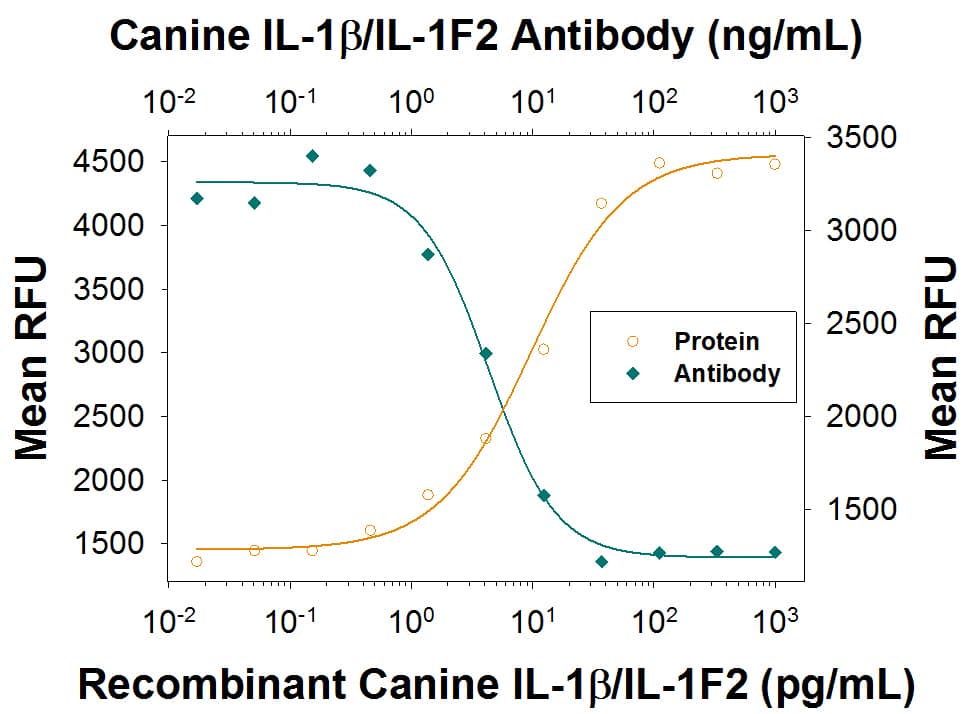Canine IL-1 beta/IL-1F2 Antibody
R&D Systems, part of Bio-Techne | Catalog # AF37471

Key Product Details
Species Reactivity
Applications
Label
Antibody Source
Product Specifications
Immunogen
Asp114-Ser265
Accession # Q28292
Specificity
Clonality
Host
Isotype
Endotoxin Level
Scientific Data Images for Canine IL-1 beta/IL-1F2 Antibody
Cell Proliferation Induced by IL-1 beta/IL-1F2 and Neutral-ization by Canine IL‑1 beta/IL‑1F2 Antibody.
Recombinant Canine IL-1 beta/IL-1F2 (Catalog # 3747-CL) stimulates proliferation in the the D10.G4.1 mouse helper T cell line in a dose-dependent manner (orange line), as measured by Resazurin (Catalog # AR002) . Proliferation elicited by Recombinant Canine IL-1 beta/IL-1F2 (20 pg/mL) is neutralized (green line) by increasing concentrations of Sheep Anti-Canine IL-1 beta/IL-1F2 Antigen Affinity-purified Polyclonal Antibody (Catalog # AF37471). The ND50 is typically 3-18 ng/mL.Applications for Canine IL-1 beta/IL-1F2 Antibody
CyTOF-ready
Neutralization
Formulation, Preparation, and Storage
Purification
Reconstitution
Formulation
Shipping
Stability & Storage
- 12 months from date of receipt, -20 to -70 °C as supplied.
- 1 month, 2 to 8 °C under sterile conditions after reconstitution.
- 6 months, -20 to -70 °C under sterile conditions after reconstitution.
Background: IL-1 beta/IL-1F2
IL-1 is a name that designates two pleiotropic cytokines, IL-1 alpha (IL-1F1) and IL-1 beta (IL-1F2), which are the products of distinct genes. IL-1 alpha and IL-1 beta are structurally related polypeptides that share approximately 22% amino acid (aa) identity in dog. Both proteins are produced by a wide variety of cells in response to inflammatory agents, infections, or microbial endotoxins. While IL-1 alpha and IL-1 beta are regulated independently, they bind to the same receptor and exert identical biological effects. IL‑1 RI binds directly to IL-1 alpha or IL-1 beta and then associates with IL-1 R accessory protein (IL-1 R3/IL-1 R AcP) to form a high-affinity receptor complex that is competent for signal transduction. IL-1 RII has high affinity for IL-1 beta but functions as a decoy receptor and negative regulator of IL-1 beta activity. IL-1ra functions as a competitive antagonist by preventing IL-1 alpha and IL-1 beta from interacting with IL-1 RI (1 - 4). The canine IL-1 beta cDNA encodes a 266 aa precursor. A 114 aa propeptide is cleaved intracellularly by the cysteine protease IL-1 beta-converting enzyme (Caspase-1/ICE) to generate the active cytokine (5, 6). The 17 kDa mature canine IL-1 beta shares 68-78% aa sequence identity with cotton rat, equine, feline, human, mouse, porcine, rat, and rhesus macaque IL-1 beta.
References
- Allan, S.M. et al. (2005) Nat. Rev. Immunol. 5:629.
- Boraschi, D. and A. Tagliabue (2006) Vitam. Horm. 74:229.
- Kornman, K.S. (2006) Am. J. Clin. Nutr. 83:475S.
- Isoda, K. and F. Ohsuzu (2006) J. Atheroscler. Thromb. 13:21.
- Accession # NP_001033060.
- Martinon, F. and J. Tschopp (2007) Cell Death Differ. 14:10.
Long Name
Alternate Names
Entrez Gene IDs
Gene Symbol
UniProt
Additional IL-1 beta/IL-1F2 Products
Product Documents for Canine IL-1 beta/IL-1F2 Antibody
Product Specific Notices for Canine IL-1 beta/IL-1F2 Antibody
For research use only
